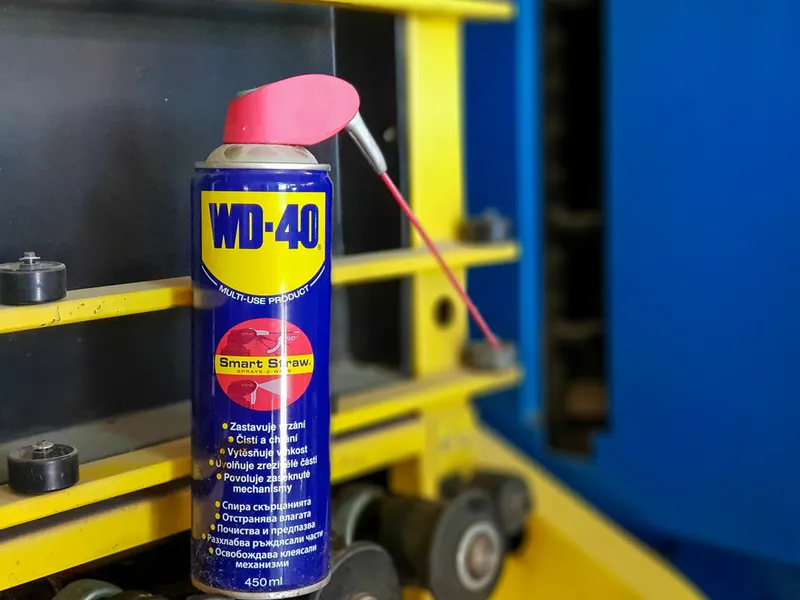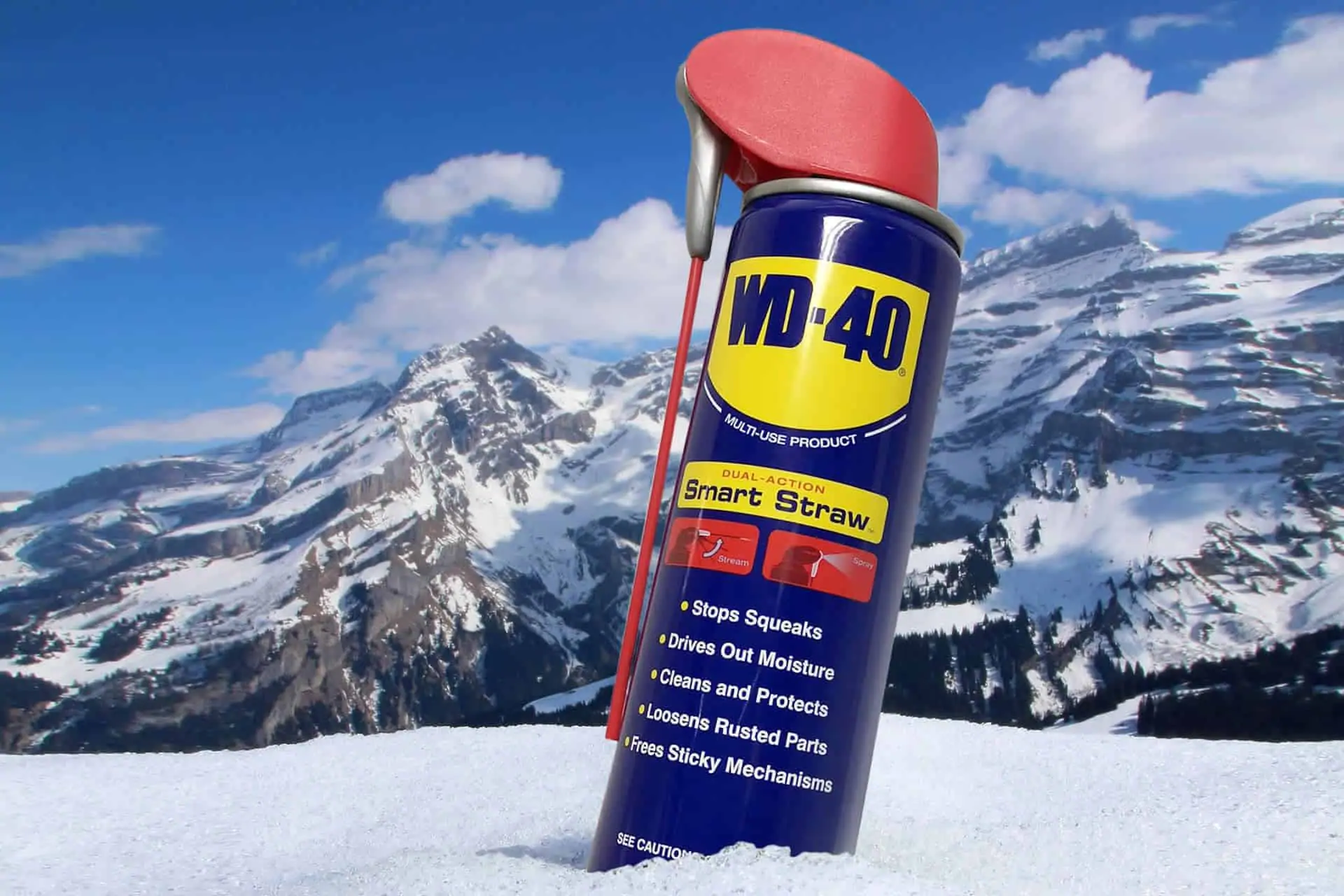Using WD-40 on your windshield for ice is not the recommended method. While it can help loosen ice and snow, it’s not as effective as dedicated de-icing products. Additionally, it may leave a residue and potentially damage your windshield and wiper blades.
So, It’s better to use products specifically designed for de-icing, such as commercial de-icers or a mixture of vinegar and water.
The Role of WD 40
WD-40 steps into the ring against icy windshields with a two-pronged attack. Its chemical composition, featuring lubricants and solvents, works to melt existing ice while forming a protective barrier against further frost.
Further, this dual-action not only makes it an efficient ice-breaker but also a preventive shield for your windshield. Its user-friendly spray mechanism ensures easy application, making WD-40 a quick and accessible solution.
Beyond ice, its versatility extends to various household uses, adding a cost-effective edge to its role in everyday problem-solving. User testimonials attest to its efficacy, making it a lubricant in a can and a reliable ally in the battle against winter’s icy grip.
Benefits of Using WD 40

Using WD-40 to combat icy windshields isn’t merely a solution; it’s a strategic choice laden with benefits. Its rapid ice-melting action ensures a quick remedy for frosty challenges, making it a time-efficient ally on chilly mornings.
Yet, its utility transcends the immediate task at hand its versatile nature extends to various household applications, from lubricating to protecting surfaces.
Now what sets WD-40 apart is not just its ability to melt ice; it forms a protective barrier, preventing re-icing and providing a longer-lasting solution. The user-friendly spray mechanism makes application a breeze, catering to DIY novices and seasoned enthusiasts. Economically, it offers a cost-effective means of winter windshield maintenance.
Furthermore, its minimal residue ensures a clear view without any sticky aftermath. Consider WD-40 not just as a winter lifesaver but as a household companion, ready to tackle a myriad of tasks with efficiency and versatility.
Alternative Methods
| Method | Description | Pros | Cons |
| Saltwater Solution | A mixture of salt and water was sprayed on the windshield to lower the freezing point. | – Inexpensive | – Potential damage to vehicle paint |
| Vinegar Spray | Equal parts vinegar and water sprayed on the windshield for ice melting. | – Natural solution | – Lingering vinegar odor |
| Rubbing Alcohol Mix | Combination of rubbing alcohol and water in a spray bottle to lower the freezing point. | – Effective in preventing re-freezing | – Use with caution on certain surfaces |
| Commercial De-Icers | Specifically formulated products designed to melt ice on windshields. | – Convenient and readily available | – May contain chemicals with environmental concerns |
| Hot Water Application | Pouring lukewarm water on the windshield to melt ice quickly. | – Rapid ice removal | – Risk of thermal shock and potential glass cracking |
| DIY Windshield Washer Fluid | Mix of water with rubbing alcohol or high-proof vodka as a homemade windshield washer fluid. | – Effective in preventing re-freezing | – Alcohol smell may be present |
| Covering Windshield Overnight | Use of tarps, cardboard, or specialized covers to prevent ice formation overnight. | – Preventive measure | – Requires advance planning and effort |
| Hair Dryer | Set the hair dryer to the highest heat setting.Hold it at a safe distance and direct hot air at the icy areas. | No risk of scratching.Controlled heating. | Takes time, dependent on power source. |
| Scraping with Tools | Traditional use of ice scraper or credit card to physically remove ice from the windshield. | – Immediate and hands-on solution | – Potential for scratches on the windshield |
How To De-Ice A Car
Step 1: Fortify Against Frost
To shield your parked car from the icy onslaught, consider a robust investment in a tarp. Secure it snugly with trusty bungee cords to thwart any mischievous attempts at blowing it off. While this method admirably fends off most ice and snow, a residual frost may linger on your windows and windshield.
Moreover, to ensure your windshield wipers steer clear of the freezing ordeal, infuse some resilience by introducing rubbing alcohol or windshield fluid into the windshield washer reservoir. For a gentle snowfall forecast, employ a nifty trick: immerse a towel in a saline solution and drape it across your windshield overnight. A caveat: reserve this tactic for lighter snowfalls, lest the towel transforms into a burdensome mass in the face of heavy snow.
Step 2: Unraveling the Icy Grip
When confronted with a frost-laden vehicle, resist the urge to unleash hot water upon your windshield, for the sudden temperature shift might conspire to crack it. Instead, delve into the arsenal of alternative methods outlined below.
Also, should time be on your side and a de-icer elude your grasp, usher your car into a warming-up session, allowing the ice to gracefully bow out. Some cars generously offer a defrost setting, a welcome ally in the fight against icy encumbrances. Prior to the ignition dance, perform a prudent check to ensure no ice barricades the tailpipe, averting the specter of carbon monoxide poisoning.
Refrain from hitting the road until the last vestiges of ice have conceded defeat, granting you unobstructed vistas through your windshield and windows.
Step 3: Embrace De-Icing Solutions
Accept the warming sensation of rubbing alcohol or a salt solution on your windshield. As the seawater works to keep the roads from freezing over again, be aware of the possibility of automobile corrosion. Choose a sensible 2:1 rubbing alcohol mixture—a non-invasive concoction that mimics the magic of melting ice while protecting your car.
If you find yourself drawn to the appeal of a specialty spray, pick one up at your neighborhood emporium and use it according to the product’s instructions.
Step 4: Liberate with a Squeegee or Scraper
As the ice capitulates, remnants may persist, obscuring your windows and windshield. Unleash the finesse of a squeegee to swiftly banish these residuals, ensuring optimal visibility. For the weightier ice barricades demanding a hastier resolution, enlist the prowess of an ice scraper. This tool facilitates a deft chipping away of the ice, fracturing it into more manageable sections.
Step 5: Attend to Your Number Plate
Your number plate enjoys the protective hug of WD-40, even though the windows and windshields may not like its presence. Use it Multi-Use to create a barrier against ice and rust while complying with country regulations requiring a number plate that is always readable.
Lastly, The unique WD-40 composition serves as both a water-repellent and a rust-preventive spray, providing your car accessory with two functions that protect it from harm.
Precautions and Considerations

- Prioritize ventilation and safety, working in well-ventilated areas with safety gear.
- Be cautious of potential corrosion from saltwater solutions; rinse the vehicle after use.
- Check compatibility with windshield wipers when adding fluids to the reservoir.
- Assess snowfall intensity before using a soaked towel; opt for alternatives in heavy snow.
- Avoid using hot water to prevent windshield cracks; opt for safer de-icing methods.
- Inspect the tailpipe for ice or snow before starting the car to prevent carbon monoxide buildup.
- Exercise caution with WD-40 on windows; use it on the number plate for rust and ice protection.
- Follow precise instructions when applying commercial de-icers or specialized sprays.
- Choose eco-friendly de-icing alternatives to minimize environmental impact.
- Establish a routine maintenance schedule to address winter-induced wear and tear.
FAQ’s
Does WD-40 prevent ice on the windshield?
No, While WD-40 isn’t recommended for windshields, applying it to your number plate can prevent ice and rust.
Does WD-40 clear ice?
Yes, WD-40 can be used to clear ice, and it’s more effective than road salt.
What is the fastest way to melt ice on a windshield?
Mix rubbing alcohol and dish soap or try vinegar and water for a quick ice-melting solution.
Does WD-40 defrost?
No, WD-40 does not thaw ice and could lead to problems if used liberally on a frosty morning.
What is the best solution for ice on the windshield?
A mix of warm water and salt, or rubbing alcohol and water, effectively removes ice from the windshield.
What can I spray on my windscreen to stop ice?
Spray a mixture of vinegar and water, rubbing alcohol and water, or a salt solution to prevent ice on your windscreen.
How do you make 100% clear ice?
Use clean water, leave the lid off in the freezer for 12–14 hours, and extract the ice before bubbles form.
Does WD-40 remove salt?
Yes, WD-40 can be used to remove salt stains from boots and shoes during winter.
Final Words
To sum up, while WD-40 may offer a temporary solution for loosening ice on a windshield, it is not the most suitable or recommended method. Using dedicated de-icing products designed for the purpose is a safer and more effective choice.
In addition, its lubricating properties may not provide the desired results, and there’s a risk of residue that could impact visibility. It’s wise to opt for products specifically formulated for de-icing to ensure the safety and integrity of your windshield and wiper blades during icy conditions.











